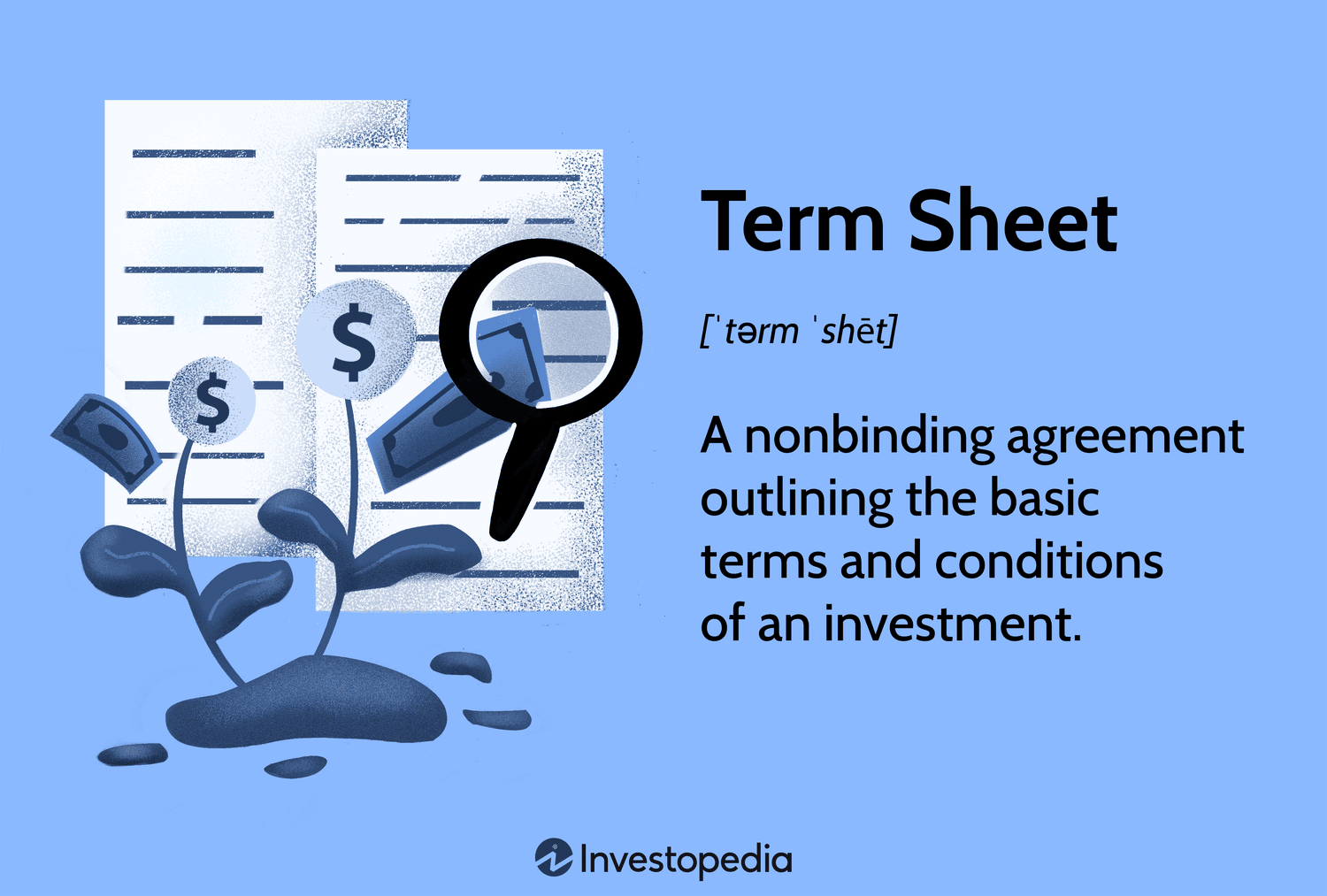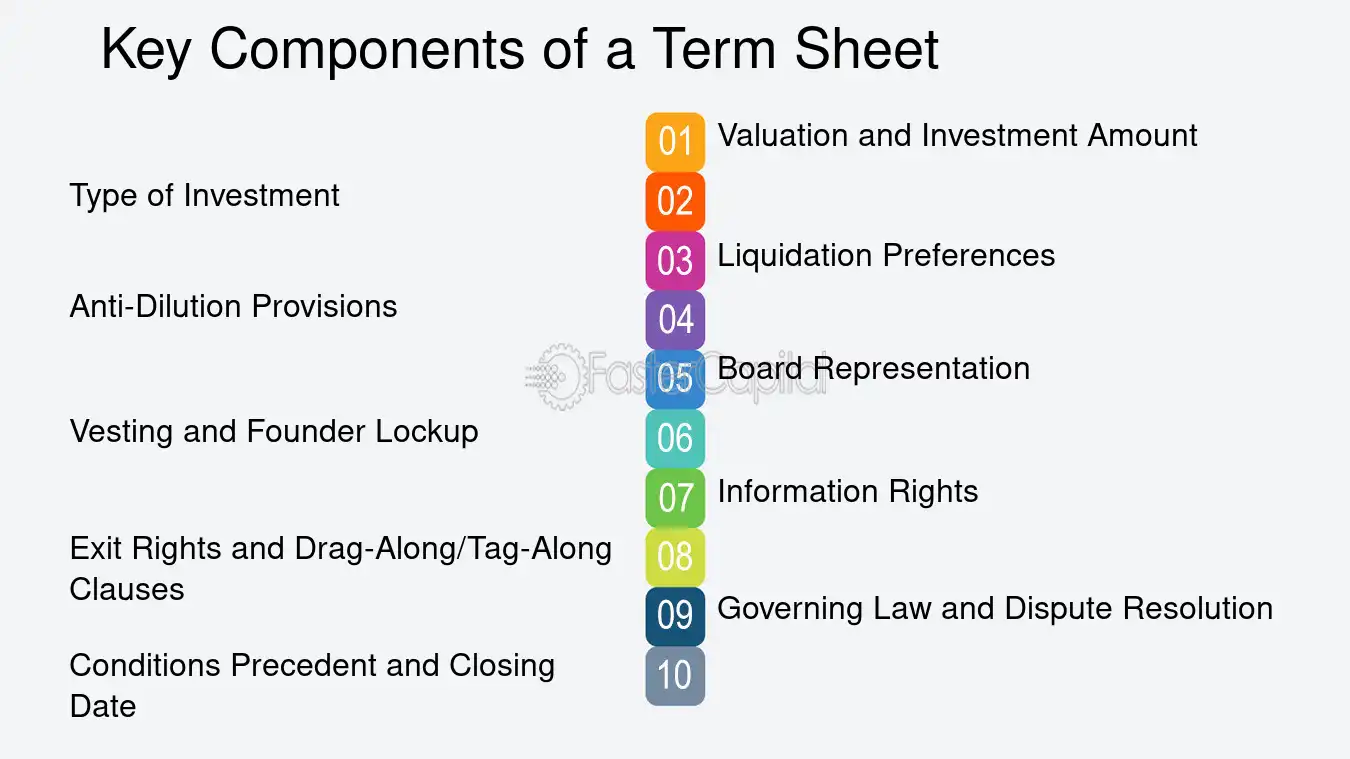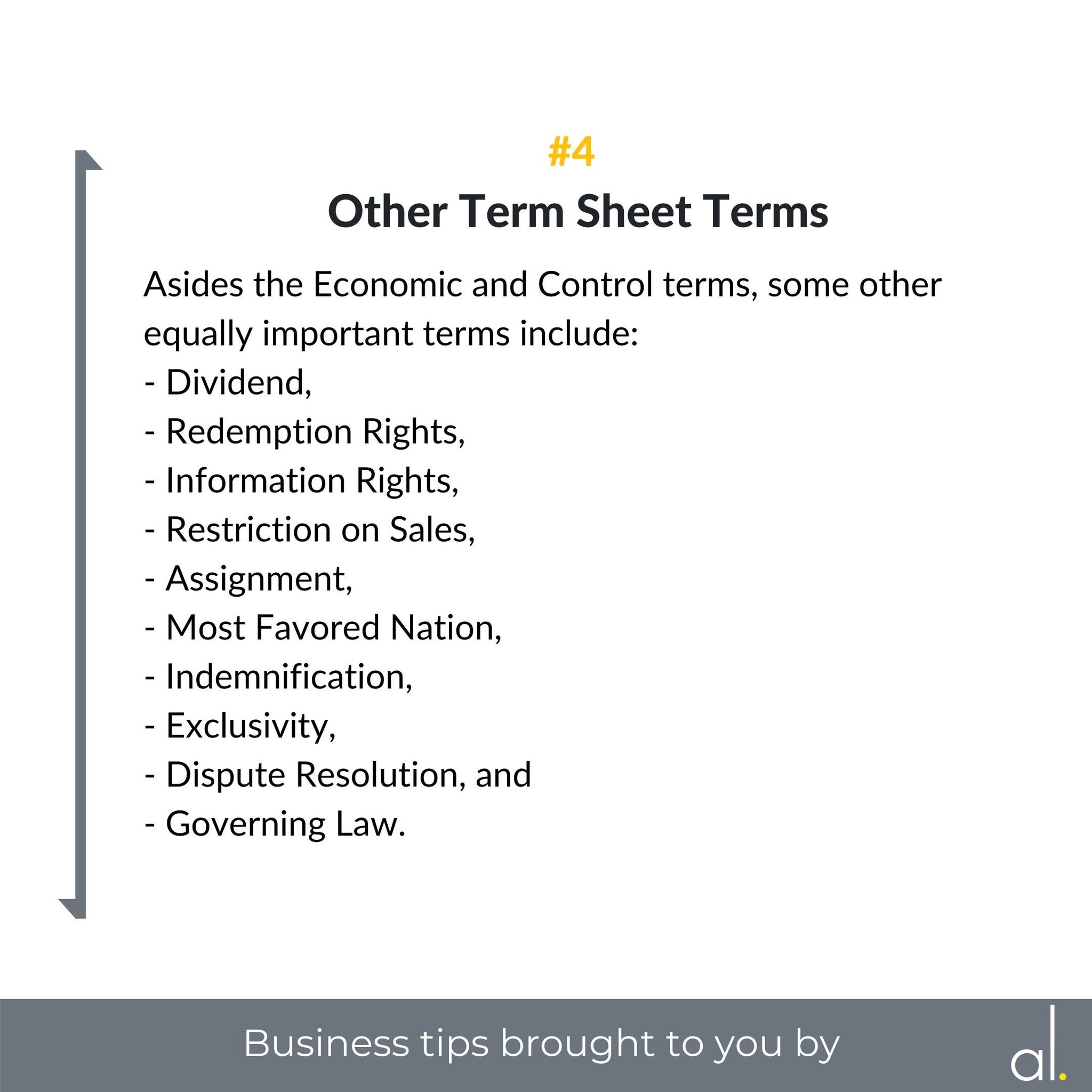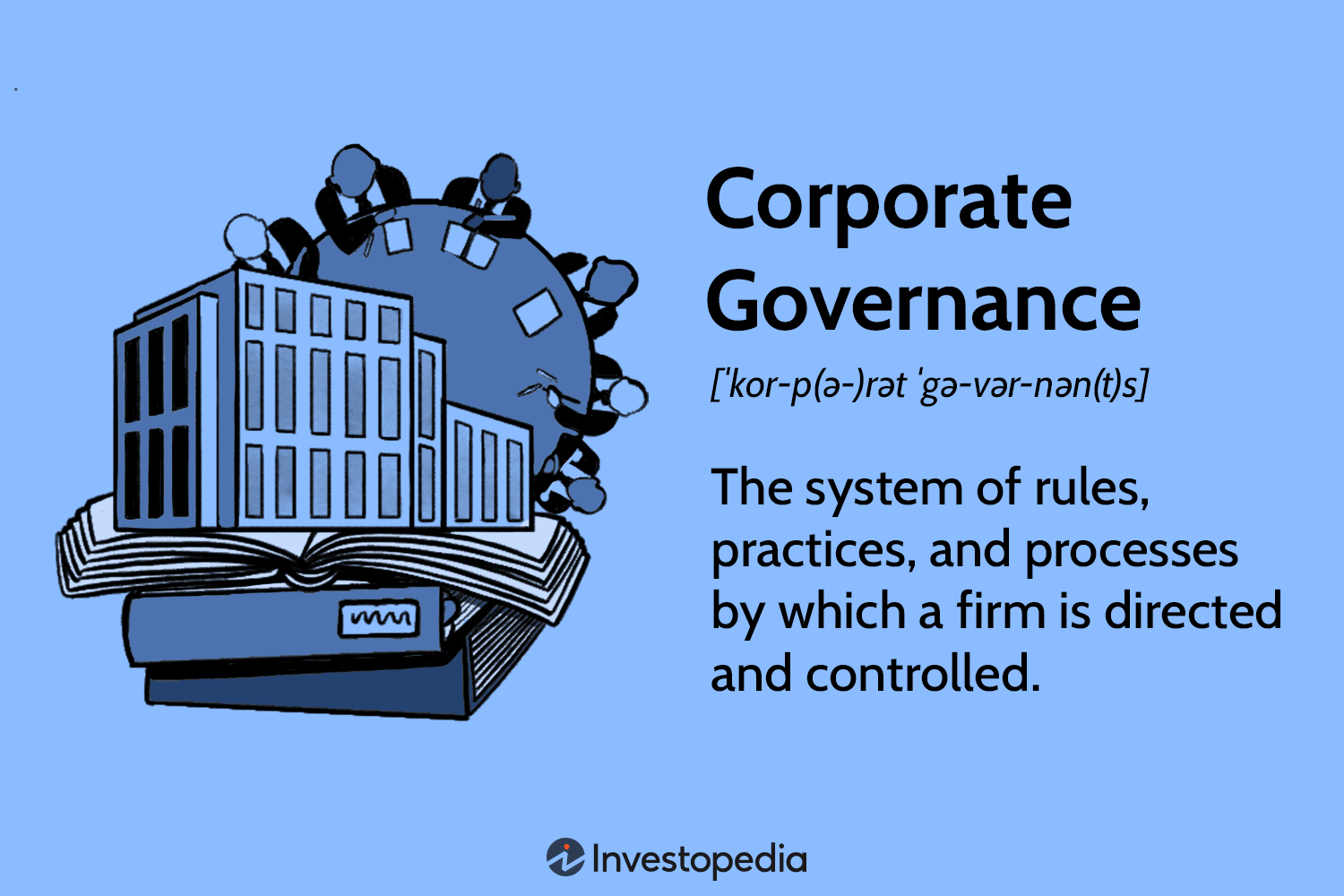In the world of venture capital, a term sheet plays a crucial role in defining the relationship between investors and startups. What is a term sheet in venture capital? It’s a non-binding document that outlines the key terms and conditions of a potential investment. This important tool serves as a foundation for negotiation and due diligence, setting the stage for a successful Series A funding round.
The term sheet covers a range of essential components, including valuation, equity stake, and governance rights. It typically addresses both economic terms, such as preferred stock and post-money valuation, and control aspects like board composition and voting rights. Understanding these key terms in a term sheet is vital for entrepreneurs and investors alike to navigate the complex landscape of venture capital financing and reach mutually beneficial agreements.
Definition and Purpose of a VC Term Sheet

What is a term sheet?
A term sheet in venture capital is a non-binding document that outlines the key terms and conditions of a proposed investment. It serves as a blueprint for the investment relationship between a startup and a venture capitalist. This important document typically spans about 500 words and lays out crucial details such as financial terms, company valuation, control mechanisms, and potential profit distribution in case of a sale or public offering.
The term sheet acts as a precursor to more detailed, legally binding agreements that follow in the investment process. It provides a framework for both parties to understand the initial offer and sets the stage for further negotiations. While most provisions in a term sheet are non-binding, it may include legally binding conditions such as confidentiality and exclusivity clauses.
Why are term sheets important?
Term sheets play a vital role in the venture capital investment process for several reasons. Firstly, they create a clear channel of communication between founders and investors, helping to limit misunderstandings and providing opportunities for re-negotiation before drawing up the final legal contract. This clarity is essential for avoiding potential conflicts and ensuring both sides are aligned from the start.
Secondly, term sheets address risk allocation and financial concepts, helping all parties involved sort out any issues or differences before executing legal agreements and undergoing time-consuming due diligence. This can save costs on premature legal expenses and give both parties the right to exit the deal with ease if necessary.
Furthermore, term sheets are crucial in defining ownership and control of the company. They detail equity distribution, voting rights, and board representation, helping founders understand how much control they will retain post-investment. This information is critical for entrepreneurs to make informed decisions about their company’s future.
Lastly, the terms agreed upon in the initial term sheet often set precedents for future funding rounds. A well-negotiated term sheet can simplify subsequent rounds of investment, making it easier to attract new investors and secure additional funding. It helps establish a track record of fair and favorable terms that can benefit the company in the long run.
When are term sheets used in the funding process?
Term sheets are typically used at a critical juncture in the funding process. They are normally negotiated after a decision is made by the venture capital firm’s investment committee following a pitch meeting with the entrepreneur. The process to arrive at a term sheet can take 6 to 12 months, and it’s worth noting that less than 5% of those who connect with a venture capitalist obtain a term sheet.
While term sheets are most commonly used in Series A funding rounds, they may also be employed in seed rounds or follow-up financings after Series A. Additionally, they can be utilized for SAFE (Simple Agreement for Future Equity) or convertible note rounds, which are instruments commonly used by accelerators.
When an investor presents a term sheet, it usually signals their readiness to proceed with the deal. Most investors will agree to provide some kind of funding after presenting a term sheet to a founder or co-founders. This makes receiving a term sheet an exciting milestone for entrepreneurs, as it indicates serious interest from potential investors and provides a sense of validation for their business model and growth potential.
Once a term sheet is signed, it triggers the due diligence process, where investors thoroughly review the company’s legal, financial, and operational aspects. The term sheet plays a crucial role by setting the preliminary terms and conditions, guiding the due diligence process, and laying the foundation for the final investment agreements.
Key Components of a VC Term Sheet

A term sheet in venture capital outlines the fundamental aspects of an investment deal. It serves as a blueprint for the investment relationship between a startup and a venture capitalist. Understanding the key components of a term sheet is crucial for entrepreneurs and investors alike to navigate the complex landscape of venture capital financing.
Valuation and investment amount
One of the most critical components of a term sheet is the valuation of the startup and the investment amount. The valuation determines the value of investors’ equity and the potential upside of their investment. It is often a point of negotiation between the startup and the VC investor, with both parties assessing the startup’s potential and market traction. Founders should be prepared to present a well-reasoned valuation based on industry benchmarks and growth projections.
The term sheet typically outlines the total investment amount and the funding structure. For example, it may state that investors propose to make an investment of up to a specific amount, such as INR [●], into the company. This investment amount is crucial as it determines the equity stake that investors will receive in exchange for their funding.
Equity and ownership structure
The term sheet details the equity ownership structure of the startup post-investment. It specifies the type of shares or equity being issued, such as convertible preferred shares. These shares often come with special rights and privileges that are not available to common shareholders. The equity structure outlined in the term sheet helps entrepreneurs understand how much control they will retain after the investment.
The post-investment shareholding structure is typically presented in a schedule within the term sheet. This schedule provides a clear picture of how ownership will be distributed among founders, investors, and other stakeholders after the investment is made.
Liquidation preferences
Liquidation preferences are a crucial component of a term sheet, as they determine how proceeds are distributed in the event of a company sale or liquidation. These preferences provide downside protection for investors by ensuring they receive a minimum return on their invested capital before other shareholders.
A standard liquidation preference typically equals the preferred shares’ original issue price multiplied by the investor’s outstanding number of preferred shares. For instance, if an investor puts in INR 418.83 million and asks for a “2x liquidation preference,” they would be entitled to the first INR 837.66 million of value when the company experiences a liquidity event.
Anti-dilution provisions
Anti-dilution provisions are clauses built into convertible preferred stocks to protect investors from potential loss of value in their investment. These provisions act as a buffer against equity ownership positions becoming diluted when new shares are issued at a lower price than previous financing rounds.
There are two main types of anti-dilution provisions: full ratchet and weighted average. Full ratchet provisions adjust the conversion price of existing preferred shares downward to the price at which new shares are issued in later rounds. Weighted average provisions use a formula to determine new conversion prices, taking into account both old and new shares and their respective prices.
Anti-dilution provisions can have significant implications for both investors and founders. While they protect investors, they can lead to dilution of common shareholders and make it more challenging to attract new investors in future rounds. Therefore, it’s essential for entrepreneurs to understand these provisions and their potential impact on the company’s capital structure.
Economic Terms in a Term Sheet

Pre-money vs. post-money valuation
In venture capital, understanding the difference between pre-money and post-money valuation is crucial for both investors and entrepreneurs. Pre-money valuation refers to the value of a company before it receives any external funding or the latest round of investment. It represents how much a startup might be worth before investors inject capital into the company. On the other hand, post-money valuation includes the external financing or the latest capital injection, reflecting the company’s value after receiving investment money.
The distinction between pre-money and post-money valuation has a significant impact on ownership percentages. For instance, if an investor agrees to invest INR 20941426.06 in a startup valued at INR 83.77 million, the ownership percentages will differ depending on whether this is a pre-money or post-money valuation. If it’s a pre-money valuation, the company will be worth INR 104.71 million after the investment, while a post-money valuation of INR 83.77 million would already include the investment amount.
Option pool
An option pool, also known as an equity pool, is a block of shares set aside by a company to issue equity to future employees, advisors, consultants, and independent contractors. While it’s called an “option” pool, the actual equity granted could be stock options or other types of equity grants like RSAs and RSUs. The option pool is an essential component of a company’s cap table, which tracks all ownership in the private company, including founders and investors.
Creating an option pool is often a requirement when raising venture capital funding. Investors typically expect portfolio companies to grant employees equity, making it an industry standard in the startup world. The size of the option pool can vary, but a common rule of thumb is that it should represent about 10% of company shares.
When negotiating a term sheet, investors may propose that the option pool be included in the pre-money valuation. This means that the creation of the option pool dilutes all shareholders, including the founders, before the investment takes place. As a result, the effective pre-money valuation of the company may be lower than initially stated.
Dividends
Dividends are payments made by a company to its shareholders, typically from profits or retained earnings. In venture capital investments, dividends are often structured as a preference for preferred shareholders, meaning investors receive their dividends before any are paid to common shareholders (founders and employees).
There are several types of dividend preferences that may be included in a term sheet:
It’s important to note that dividends in venture capital financing deals for startups are not very common. Most startups focus on growth and reinvesting profits back into the business rather than distributing them as dividends. However, when included, dividend preferences are often cumulative, meaning unpaid dividends accrue and must be paid before any dividends are paid to common shareholders.
Understanding these economic terms in a term sheet is crucial for entrepreneurs and investors alike when negotiating Series A funding rounds and conducting due diligence. By carefully considering these components, both parties can work towards a mutually beneficial agreement that aligns with their goals and expectations.
Control and Governance Terms

Board composition
The board of directors plays a crucial role in the governance of a venture capital-backed startup. The term sheet typically outlines the proposed structure of the board, which often reflects a balance between founders, investors, and independent directors. A common board composition for an initial investment includes an odd number of directors representing both founders and institutional investors.
The lead investor from the venture capital firm usually takes a board seat, while the remaining seats are allocated to founders and independent directors. Independent directors are individuals who do not have a formal employment relationship or affiliation with either the entrepreneurs or the venture capitalists but possess strong expertise in the industry.
A balanced board structure is often preferred, as it fosters collaboration and trust between founders and investors. This approach offers equal seats to both parties, with the addition of independent directors to provide unbiased oversight. However, some founders may opt for a founder-controlled board, especially in early stages when flexibility and experimentation are crucial.
Voting rights
Voting rights are a critical component of control and governance terms in a term sheet. Investors typically receive voting rights equal to the number of shares of common stock into which their preferred stock may convert. This ensures that investors have a say in major company decisions proportional to their investment.
In addition to standard voting rights, investors may request special approval rights for matters of particular significance to their investment. These are often referred to as “protective provisions” and require the approval of preferred stockholders for certain corporate actions.
Protective provisions
Protective provisions give preferred shareholders the right to veto specific corporate actions that could impact their investment. These provisions are designed to protect minority shareholders’ interests and are a standard feature in venture capital deals.
Common protective provisions include:
Less common protective provisions may cover actions such as hiring or firing executive officers, adjusting executive compensation, taking on new debt, or making significant shifts in business strategy.
While protective provisions are crucial for investors to safeguard their interests, they can also create control dynamics that founders should be aware of. These provisions can compel founders to compromise on big decisions for their company, even if they retain majority ownership.
It’s important for founders to negotiate these terms carefully, as they can significantly impact the company’s future decision-making processes. Some provisions may be non-negotiable, while others may allow for carve-outs or exceptions. For example, founders might negotiate for carve-outs in stock repurchase provisions to allow for buying back unvested stock from departing employees.
Understanding the implications of control and governance terms in a term sheet is crucial for both founders and investors. These terms shape the decision-making process and power dynamics within the company, ultimately influencing its growth and success in the competitive startup landscape.
Negotiating a VC Term Sheet

Identifying key terms to focus on
When negotiating a term sheet in venture capital, it’s crucial to identify and prioritize the most important terms. For founders, the key issues typically revolve around valuation, dilution, board control, and voting rights. These terms directly impact the amount of equity given up and the level of control maintained over key decisions. Investors, on the other hand, are primarily concerned with downside protection through liquidation preferences and anti-dilution provisions, as well as governance rights such as board seats and protective provisions.
To effectively negotiate a term sheet, founders should prioritize the terms that could potentially have the most significant impact on the company’s future. A helpful approach is to ask, “What are the terms that could potentially kill the company if we agree to them?” This framework allows founders to focus on the must-haves, nice-to-haves, and points that can be conceded during negotiations.
Tips for effective negotiation
One of the most effective strategies for securing better terms in a term sheet is to create a competitive dynamic by having multiple interested investors. This approach shifts the leverage to the company and encourages investors to offer more favorable terms, particularly regarding valuation and other key points. To create this dynamic, founders should run a well-structured fundraising process with a tight timeline, meeting with multiple qualified investors and keeping them aligned in terms of due diligence and negotiations.
Engaging experienced legal counsel is crucial when negotiating a term sheet. Many startups work with law firms that specialize in venture deals, as they have extensive experience with market norms and can help founders reach a fair deal quickly. Additionally, seeking advice from experienced entrepreneurs, investors, and advisors who have been through the process before can provide valuable insights and guidance.
It’s essential to balance the short-term goal of closing the deal with the long-term impact on the company’s future financing and exit options. Founders need to consider the implications of each term not just for the current round but for future rounds as well. Maintaining flexibility for potential pivots and strategic decisions is key to ensuring the company’s long-term success.
Common pitfalls to avoid
One common pitfall in term sheet negotiations is agreeing to unfavorable liquidation preferences. Accepting a multiple-liquidation preference (greater than 1X) or a participating preferred with no cap can significantly impact the distribution of proceeds in an exit scenario. These terms can also make it challenging to raise future rounds from new investors, who would have to come in behind the prior investors in the preference stack.
Another mistake to avoid is giving up too much control of the board and key governance rights. Founders should strive to maintain at least equal representation on the board, if not an outright majority. It’s also important to be cautious about agreeing to broad protective provisions that give investors veto power over critical decisions such as hiring or firing key employees, setting budgets, or pivoting the business model.
Startups should also be thoughtful about equity allocation for employees. Failing to reserve enough shares for future hires or allocating too much to early employees before the company has proven itself can create problems down the line. Founders should work with their investors and legal counsel to size the option pool appropriately based on their hiring plans and industry benchmarks.
By carefully identifying key terms, employing effective negotiation strategies, and avoiding common pitfalls, founders can navigate the term sheet negotiation process more successfully and secure favorable terms for their venture capital investment.
Conclusion
Term sheets play a crucial role in the venture capital landscape, serving as a roadmap for potential investments. They outline key financial and governance terms, helping both founders and investors align their expectations and interests. Understanding the components of a term sheet, from valuation and equity structure to board composition and protective provisions, is essential to navigate the complex world of startup financing.
Negotiating a term sheet requires careful consideration of short-term and long-term implications. By focusing on key terms, creating a competitive dynamic, and avoiding common pitfalls, founders can secure more favorable terms that support their company’s growth. In the end, a well-negotiated term sheet sets the stage for a successful partnership between startups and investors, paving the way for future funding rounds and potential exits.
FAQs
What exactly is a term sheet in the context of venture capital?
A term sheet in venture capital is a nonbinding document that outlines the basic terms and conditions of an investment. It is particularly significant in the startup ecosystem, helping entrepreneurs to attract venture capitalists who provide the necessary funding for their businesses.
Can you list some critical elements typically included in a term sheet?
Key elements of a term sheet can include the credit delivery amount and timing, guarantees, reserves, options for exit in year 15, and implied costs for third-party reports.
How would you describe a term sheet?
A term sheet is essentially a bullet-point document that sets out the main terms and conditions for a potential business agreement. It marks the initial step in the negotiations between a seller and a buyer, laying the groundwork for more detailed discussions and agreements.
What is the main difference between a term sheet and a Letter of Intent (LOI)?
The primary difference lies in their format and detail level. A Letter of Intent (LOI) is typically formatted as a letter and is more detailed, often sent from a potential buyer to a seller. In contrast, a term sheet is usually less formal, often presented in bullet points or an outline format, summarizing the key aspects of a proposed deal.




